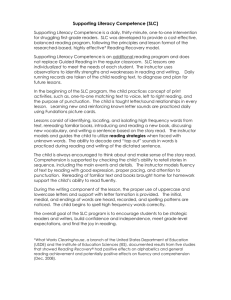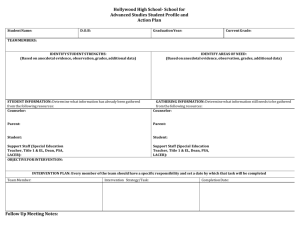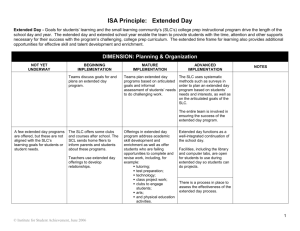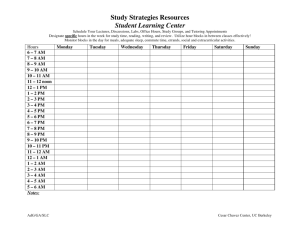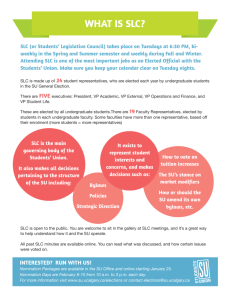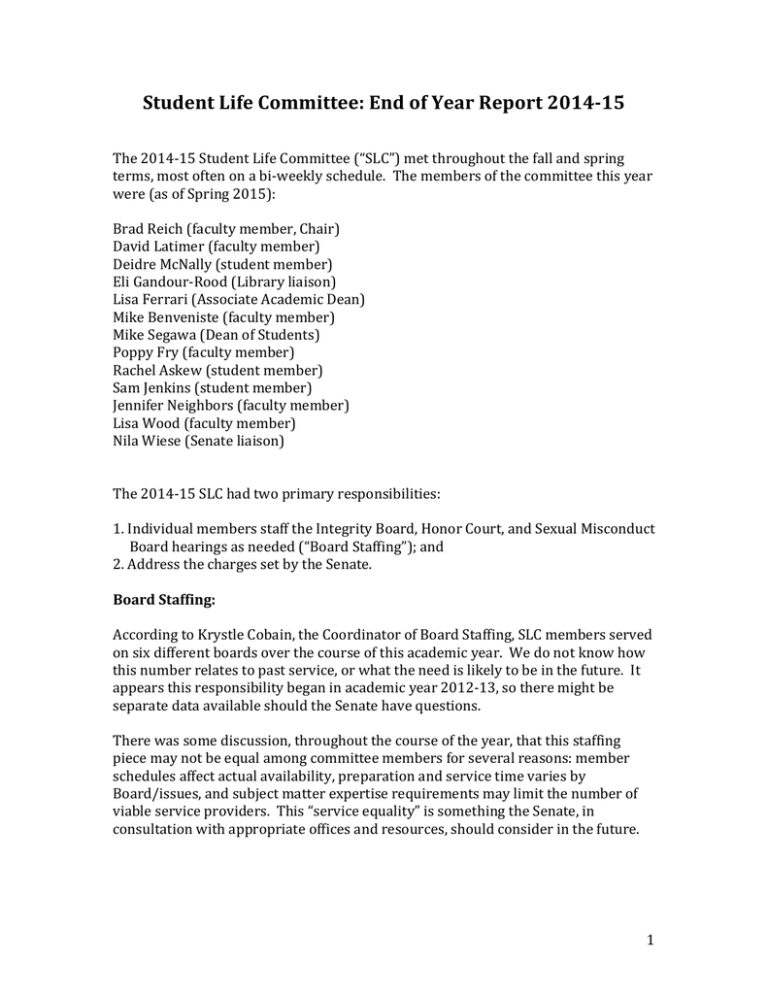
Student Life Committee: End of Year Report 2014-­‐15 The 2014-­‐15 Student Life Committee (“SLC”) met throughout the fall and spring terms, most often on a bi-­‐weekly schedule. The members of the committee this year were (as of Spring 2015): Brad Reich (faculty member, Chair) David Latimer (faculty member) Deidre McNally (student member) Eli Gandour-­‐Rood (Library liaison) Lisa Ferrari (Associate Academic Dean) Mike Benveniste (faculty member) Mike Segawa (Dean of Students) Poppy Fry (faculty member) Rachel Askew (student member) Sam Jenkins (student member) Jennifer Neighbors (faculty member) Lisa Wood (faculty member) Nila Wiese (Senate liaison) The 2014-­‐15 SLC had two primary responsibilities: 1. Individual members staff the Integrity Board, Honor Court, and Sexual Misconduct Board hearings as needed (“Board Staffing”); and 2. Address the charges set by the Senate. Board Staffing: According to Krystle Cobain, the Coordinator of Board Staffing, SLC members served on six different boards over the course of this academic year. We do not know how this number relates to past service, or what the need is likely to be in the future. It appears this responsibility began in academic year 2012-­‐13, so there might be separate data available should the Senate have questions. There was some discussion, throughout the course of the year, that this staffing piece may not be equal among committee members for several reasons: member schedules affect actual availability, preparation and service time varies by Board/issues, and subject matter expertise requirements may limit the number of viable service providers. This “service equality” is something the Senate, in consultation with appropriate offices and resources, should consider in the future. 1 Faculty Senate Charges for the Student Life Committee The following charges came to the SLC in two pieces. Charges 1-­‐5 arrived at the beginning of academic year 2014-­‐15. Charge 6 came from the Senate in March of 2015. To the extent practically possible, members of the SLC addressed the charges simultaneously and often in inter-­‐related fashions. Accordingly, there was some overlap between charges, and parameters of individual charges evolved over time. The charges are listed collectively, then discussed individually. Charge 1 -­‐ Identify initiatives to increase faculty awareness regarding sexual assault issues on campus and faculty’s reporting obligations. Charge 2 -­‐ Appoint a Student Life Committee member to serve on the Sexual and Gender Violence Committee (SGVC). The SLC faculty representative to the SGVC will report back to the full Student Life Committee with any specific recommendations of relevance to the faculty. Charge 3 -­‐ To identify initiatives or mechanisms for enriching (1) the academic component integrated into the first year experience (e.g. Prelude): and (2) the intellectual life on campus (i.e., outside the classroom). Charge 4 -­‐ Conduct a self-­‐evaluation of the SLC’s standing charges and current responsibilities, and make recommendations to the Faculty Senate for changes that would enhance the efficiency and relevance of the work conducted by the committee (including ASUPS liaison functions and other advisory roles). Charge 5 -­‐ With respect to the work of the committee during 2014-­‐15, indicate in your end of year report whether the size of the committee was appropriate and identify and work that seemed superfluous. Charge 6 (added March, 2015) -­‐ The Faculty Senate requests that the Student Life Committee in the 2014-­‐2015 Academic Year investigate the principles, policies, and practices that guide decision-­‐makers institutional as well as individual in determining 1) what sorts of expressions or activities lie within protected “freedom of expression;” 2) what sorts of expressions or activities fall outside protected “freedom of expression;” and 3) what sorts of expressions or activities “straddle” protected “freedom of expression.” Charge 1: Identify initiatives to increase faculty awareness regarding sexual assault issues on campus and faculty’s reporting obligations. In carrying out this charge, the working group focused first upon the initiatives to raise student awareness of sexual assault; this work is complete. The efforts centered on raising staff and faculty awareness are ongoing. 2 Student awareness First, the group examined the web-­‐based and print resources available for students. The university’s web-­‐based resources are exhaustive if a bit labyrinthine. The main portal appears under the Title IX arm of the Diversity page: http://www.pugetsound.edu/about/diversity-­‐at-­‐puget-­‐sound/title-­‐ix/ . It contains information for aiding victims in reporting sexual assault as well as contact information for survivor support groups. Steps for reporting assault are clearly outlined including links to community resources (e.g., the Sexual Assault Center of Pierce County, Tacoma General). Two print pamphlets, “Sexual Harassment and Sexual Assault Survival Guide” and “Sexual Harassment and Sexual Assault Prevention Guide”, more concisely summarize this web-­‐based information. The group met with Marta Palmquist-­‐Cady, Assistant Dean of Students, to learn about sexual assault awareness initiatives promoted by the Dean of Students office and student groups. Marta outlined the semester’s activities related to sexual assault awareness. There have been about two to three events per semester. First-­‐
year orientation involved a consent workshop and Green Dot talk in August. Later in the semester, there were several Green Dot training programs and other events like Take Back the Night. I’ve attached the summary from Marta (not attached to this report). As for student groups, Marta said that Peer Allies, SIRGE, and the Green Dot program are currently the most active relevant groups on campus. The working group expressed to Marta our desire to provide a means by which victims of sexual assault might more easily access the relevant web-­‐based information. The group suggested placing in all campus bathrooms posters with QR codes linked to the university’s “Reporting Harassment or Sexual Assault” page. Marta agreed with the idea and showed [us] Whitman College’s solution to this problem. Administrators at Whitman have printed two-­‐sided…cards containing information for victims of sexual assault. The cards provide college and community contact information as well as QR codes linking the college’s Green Dot program and Online Complainant Report form; a copy of one of theses cards is attached. Plastic sleeves containing these cards are affixed to the backs of all bathroom stall doors throughout the college. Recommended action: The Student Life Committee endorses the printing and distribution of information cards analogous to those produced by Whitman College. We recommend to the Dean of Students that funds be allocated for this purpose. Faculty and Staff Awareness The group met with Nancy Nieraeth on December 3, 2014, to discuss initiatives directed toward the staff to raise awareness about sexual assault issues and reporting obligations. Nierath has been working with Michael Benitez to identify an effective web-­‐based training module for the staff. Staff must complete the training module every two years. Additionally, Nieraeth planned several professional development sessions in January of 2015. Since this discussion, the web-­‐based 3 training session has been rolled out for the staff, and four professional development sessions, led by Michael Benitez and Marta Palmquist-­‐Cady, were held in January of 2015. The group met with Michael Benitez on December 4, 2014, to discuss initiatives directed toward faculty to raise awareness about sexual assault issues and reporting obligations. As stated above, Benitez and Nieraeth worked together to find a much improved web-­‐based training module on discriminatory harassment and sexual assault prevention. Benitez stressed the importance for full faculty participation in the training and was considering different ways to enforce full participation (e.g., tying the training to the faculty evaluation process, or linking it to salary raises). Benitez also suggested a creative way that the university faculty might support sexual/gender violence awareness – they could make a video similar to the one produced by ASUPS and BHERT (https://www.youtube.com/watch?v=I-­‐P-­‐
NwgH_5c#t=14) as part of the Wyatt Desk Bias Awareness and Action Initiative. Since the meeting, the web-­‐based module has been rolled out. Several members of the SLC thought that it would be useful to ascertain the faculty’s current awareness of local sexual assault issues and its understanding of university policies. Rather than gather anecdotes from the listserv, the working group requested that Dean Kris Bartanen ask department chairs to solicit this feedback from department chairs. Namely, the SLC was interested in: (i) What knowledge do faculty have of sexual assaults involving students on campus? Does this knowledge come from an alleged victim, alleged perpetrator, a sexual assault board, or is it hearsay? (ii) What would faculty like to know about the issue of sexual assault as it pertains to UPS? (iii) Are there any changes in practices that the faculty would like to see with respect to the issue? (iv) What is the faculty’s sense of the severity of the problem on campus? Bartanen declined the request but suggested that we might use the campus climate survey as a means to gather this information. Members of the SLC felt that the campus climate survey was not an effective way to gather the kind of information it sought, so the matter was not pursued. Charge 2: Appoint a Student Life Committee member to serve on the Sexual and Gender Violence Committee (SGVC). The SLC faculty representative to the SGVC will report back to the full Student Life Committee with any specific recommendations of relevance to the faculty. In addition to volunteering to serve as our committee secretary on most occasions, Prof. Poppy Fry also served as our sole representative for this charge. She provides the following: 4 In the fall semester I began making connections with the Sexual and Gender Violence Committee and with other organizations and individuals dealing with sexual violence on campus. I met with Marta Palmquist-­‐Cady and she briefed me on the current initiatives. I also attended SGVC meetings and joined the policy and procedure subcommittee. I attended one of the student speak-­‐ups sponsored by the SGVC. In addition, I served on Sexual Misconduct Boards, which allowed me to see Puget Sound’s conduct process in action and to better understand the context of the SGVC. I met repeatedly with Sarah Shives and Krystle Cobian regarding both the specific cases and the broader questions around adjudicating sexual assault on campus. I continued as a member of the SGVC and a member of the policy and procedure subcommittee [through the remainder of the academic year]. In the latter capacity, I helped formulate a timeline and plan for procedure changes and for bringing potential policy changes to faculty, staff, and the board of trustees. I met with Alisa Kessel, who has been formulating a new model for faculty engagement with issues of sexual assault. In May I will undergo Title IX investigator training to more thoroughly prepare for further Sexual Misconduct Boards and to convey the process to the faculty via the SLC. Procedural Note: Charges 1 and 2 are discussed above. Charges 3-­‐6 will be discussed below, but the key to understanding SLC actions regarding those charges is the Motion to Revise SLC Procedures. We provide that Motion now, immediately followed by the remaining charges and attendant committee actions. Motion to Revise SLC Procedures1 Rationale: As a major part of its work this year, SLC members have served in a liaison capacity to one or more ad hoc groups addressing current issues related to student life, serving primarily as conduits for information between committees and the Senate. It makes sense to consider a larger role for the SLC in ad-­‐hoc committees that are working to implement new programming and policy related to student life. 1 M/S/P March 9, 2015, amended April 21, 2015 (M/S/P, unanimously). 5 We propose the following five-­‐part motion: 1. Procedures for the SLC will be revised so that members will participate more fully in ad hoc campus committees or special projects related to student life. In this way, faculty serving on the SLC will be able to weigh in directly on current issues and planning. 2. In parallel with these proposed modifications, student, administrative, and staff members of the SLC will be assigned to work on projects and committees along with faculty. 3. Members of the SLC would retain the right to initiate projects in the absence of current ad hoc committee work or special projects identified by the Faculty Senate in their charges. 4. The Faculty Senate would continue to direct charges to, and discuss progress with the committee as needed. Procedures for implementing Senate charges (in relation to the use of SLC faculty on other committees/working groups) will be modified through a consultative process between the Dean of Students, Chair of the SLC, Faculty Senate liaison, and other individuals if necessary. The SLC will also make recommendations about future charges through regular communication with the Senate Liaison as part of its work during the course of the academic year. 5. The following procedural issues and questions require further clarification. It is expected that these questions will be addressed during the course of the next year as this model is piloted. a. How faculty, students, & staff will be selected for the SLC if their participation will also entail work on other student life committees or projects. Will there need to be any changes in that process? b. How will workload issues be addressed in the future, given SLC members’ additional participation on other committees or working groups? How will issues of balance and fairness be monitored and adjusted if necessary? c. How will the work of the whole committee change (number of meetings, role of the chair, individual reporting responsibilities re: liaison work) as a result of this shift in responsibilities for members? d. Will there be a need for additional administrative support for committee members with this model in place (e.g. secretarial support, having staff support in meetings for note-­‐taking, or copying and distributing documents)? Charge 3: To identify initiatives or mechanisms for enriching (1) the academic component integrated into the first year experience (e.g. Prelude): and (2) the intellectual life on campus (i.e., outside the classroom). 6 The SLC discussed the feasibility of Charge 3, particularly during the Spring of 2015. Those in attendance agreed that a) in light of other groups on campus, this Charge was redundant, at least in part(s)2, and b) the totality of this Charge could more effectively be carried out under then pending (within the SLC) Motion to Revise SLC Procedures. After the Motion to Revise SLC Procedures was approved by the SLC, a motion was M/S/P that working group 3 disband, while still maintaining the committee’s commitment to the first year experience and intellectual life on campus. Charge 4: Conduct a self-­‐evaluation of the SLC’s standing charges and current responsibilities, and make recommendations to the Faculty Senate for changes that would enhance the efficiency and relevance of the work conducted by the committee (including ASUPS liaison functions and other advisory roles). Working group 4 presented the original Motion to Revise SLC Procedures. It passed unanimously. Charge 5: With respect to the work of the committee during 2014-­‐15, indicate in your end of year report whether the size of the committee was appropriate and identify and work that seemed superfluous. There are two components to this response and they largely depend on Senate action regarding the Motion to Revise SLC Procedures. First, if the SLC remains “as is”, we do not have a concrete response to the size issue. Our committee has approximately 12 members, several with different forms of standing or designation. 100% attendance, at SLC meetings, was extremely rare. Extremely. Accordingly it is unclear if we should have more members, with the expectation that only a percentage will be at any given meeting, or if there is another avenue or mechanism to facilitate better attendance. Second, if the Motion is adopted as set forth, we will not understand true staffing needs for some period of time, as this will constitute a brand new undertaking. We see no reason committee size would change now, but lack sufficient evidence to predict future needs or trends. Charge 6: The Faculty Senate requests that the Student Life Committee in the 2014-­‐
2015 Academic Year investigate the principles, policies, and practices that guide 2 At the time this was discussed, there was also an existing Prelude Committee and a First Year Experience Task Force. 7 decision-­‐makers institutional as well as individual in determining 1) what sorts of expressions or activities lie within protected “freedom of expression;” 2) what sorts of expressions or activities fall outside protected “freedom of expression;” and 3) what sorts of expressions or activities “straddle” protected “freedom of expression.” Charge 6 came to the SLC fairly late in the year. However, it provides an excellent vehicle for discussing the proposed Motion to Revise SLC Procedures. The fundamental purpose of the Motion is to more efficiently carry out the SLC’s role as specified in the By-­‐Laws (in pertinent part): To act as a liaison on student life issues among students, staff, faculty, and the administration. This includes providing input on various Student Affairs projects and initiatives as brought to the Committee by the Dean of Students….3 To the best of SLC knowledge, the Senate sent this charge to the SLC, PSC, and Diversity Committee/BHERT simultaneously, and without specified sequencing. The PSC conducted initial analysis of the Faculty Code, identifying three areas for future discussion. It then passed this information onto the SLC, who had also begun work on the charge. It quickly became obvious, in light of both substantive and procedural concerns, that an ad hoc committee was required because this, like many student life issues, involved multiple parties in the campus community. The SLC then drafted a motion4 regarding that ad hoc committee. Pursuant to that motion, and in conjunction with the Dean of Students, an ad hoc committee would be formed comprised of: three members of the SLC (including one student member), two members of BHERT, two members of PSC, one member of library staff, and the Dean and or his/her designee. Charge 6 provides practical context for the Motion to Revise SLC Procedures as this is the type of model and interaction the SLC recognizes, and foresees, as commonplace in student life issues at Puget Sound. To be clear, this is not a Motion to change traditional charging authority; it is a motion to modify implementation of charges addressed by the SLC. Conclusion The SLC worked diligently this year, not only in terms of the assigned Charges and Board Staffing responsibilities, but to genuinely examine the past actions, current challenges, and future needs of a Senate committee focusing on student life. This year actually built on discussions beginning in 2013-­‐14, so we did not reach our conclusions and recommendations quickly or lightly. We strongly urge the Senate to approve the Motion to Revise SLC Procedures and we look forward to working, across campus, to better address student life issues. 3 Faculty By-­‐Laws 2014-­‐15. 4 The motion is pending (internally with the SLC) as it directly relies on the Senate’s action regarding the also pending Motion to Revise SLC Procedures. 8 Respectfully submitted, Brad Reich Chair, Student Life Committee 2014-­‐15 9


